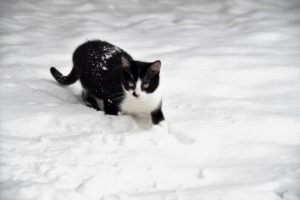
Your cat might be growing its winter coat right now; learn more about their natural winter protection here.
Cats comprise a vast collection of species that all count as household pets. Whether they are long-haired or have no hair at all, they need a way to stay warm during the fall and winter. Cats that have fur will shed twice a year, and this shedding can look different between breeds and climates. Cats do have winter coats; learn more about them below!
What Is a Winter Coat?
A cat’s winter coat is an undercoat of millions of fine hairs, usually a light-grayish color. This undercoat, in summer or winter, provides extra insulation from heat and cold. Cats use thermoregulation to regulate body temperature; their hairs close together to protect against cold and spread out when ventilation is necessary.
How Does It Work?
There’s more to a cat’s winter coat than general insulation. The cat’s winter coat will grow based not on temperature, but on sunlight exposure. The shorter the days grow, the quicker the coat will grow. When the days lengthen, the cat’s body will cause it to shed its thick undercoat.
Shedding Expectations
The thickness of the undercoat may depend on the cat’s breed and climate. A short-haired cat will not necessarily produce the same rich, fluffy coat that a long-haired cat would. Even so, you can know that it is there. Because the coat grows and sheds based on daylight exposure, it will grow in mid-fall and shed in late spring. The cycle also applies whether your cat is an indoor or outdoor pet.
Shedding Management
Shedding can lead to your house getting covered with cat hair on all surfaces. One way of limiting the cat hair about the house is to use a lint roller on all your furniture, bedding, and clothing regularly. Another tip is to brush your cat with an appropriate tool, especially during shedding season. You can catch a lot of the fur during a brushing session rather than around the house over a few weeks. Even so, the vacuum cleaner is a handy tool for getting all cat hairs no matter the season.
Cat Care During Winter
Even though cats have an extra layer of protection, it doesn’t mean they can’t get cold. Cat owners should still look out for signs of coldness and overheating and help prevent either of these scenarios indoors or outdoors.
Trust the Care of Your Pet to the Professionals at Everhart Veterinary Medicine!
At Everhart Veterinary Medicine, our veterinary professionals strive to provide your pet with the very best of veterinary care. We believe that the best care for your pet should be provided by experienced, compassionate, and knowledgeable veterinary professionals. With two Maryland locations in both Baltimore and Pasadena, we are always ready to welcome your pet as a new patient! Give us a call today at 410-355-3131 or 410-793-7670! For more information, as well as updates on veterinary news and topics, visit us on Facebook, Twitter, or LinkedIn!
